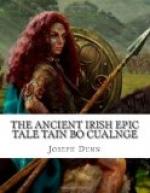“On to battle now he
comes;
If ye watch not, ye are doomed.
This is he seeks ye in fight
Brave Cuchulain, Sualtaim’s
son!
“All your host he’ll smite in twain, Till he works your utter ruin. [W.291.] All your heads ye’ll leave with him. Fedelm, prophet-maid, hides not!
“Gore shall flow from warriors’ wounds; Long ’twill live in memory. [LL.fo.56b.] Bodies hacked and wives in tears, Through the Smith’s Hound[a] whom I see!”
[a] The Eg. 1782 version
of this poem differs in several details
from LL.
[b] That is, Cu Chulain, ‘the Hound of Culann.’
[1-1] Tranlating from LU. 65, Stowe and Add.
[c] The Gae Bulga, ‘barbed spear,’ which only Cuchulain could wield.
[2-2] Translating from LU.
72, Add. and Stowe; ‘from the left,’ as
a
sign of enmity.
[a] That is, Cuchulain. See page 17.
Thus far the Augury and the Prophecy and the Preface of the Tale, and the Occasion of its invention and conception, and the Pillow-talk which Ailill and Medb had in Cruachan. [1]Next follows the Body of the Tale itself.[1]
[1-1] Stowe and Add.
* * * * *
[Page 19]
V
THIS IS THE ROUTE OF THE TAIN
[W.301.] and the Beginning of the Expedition and the Names of the Roads which the hosts of the four of the five grand provinces of Erin took into the land of Ulster. [1]On Monday after Summer’s end[1] [2]they set forth and proceeded:[2]
[1-1] LU. 81.
[2-2] Eg. 1782.
[3]South-east from Cruachan Ai,[3] by Mag Cruimm, over Tuaim Mona (’the Hill of Turf’), by Turloch Teora Crich (’the Creek of three Lands’), by Cul (’the Nook’) of Silinne, by Dubloch (’Black Lough’), [4]by Fid Dubh (’Black Woods’),[4] by Badbgna, by Coltain, by the Shannon, by Glune Gabur, by Mag Trega, by Tethba in the north, by Tethba in the south, by Cul (’the Nook’), by Ochain, northwards by Uatu, eastwards by Tiarthechta, by Ord (’the Hammer’), by Slaiss (’the Strokes’), [5]southwards,[5] by Indeoin (’the Anvil’), by Carn, by Meath, by Ortrach, by Findglassa Assail, (’White Stream of Assail’), by Drong, by Delt, by Duelt, by Delinn, by Selaig, by Slabra, by Slechta, where swords hewed out roads before Medb and Ailill, by Cul (’the Nook’) of Siblinne, by Dub (’the Blackwater’), by Ochonn [6]southwards,[6] by Catha, by Cromma [7]southwards,[7] by Tromma, [8]eastwards[8] by Fodromma, by Slane, by Gort Slane, [9]to the south of[9] Druim Licce, by Ath Gabla, by Ardachad (’Highfield’), [W.356.] [1]northwards[1] by Feorainn, by Finnabair (’White Plain’), by Assa [2]southwards,[2] by Airne, by Aurthuile, by Druim Salfind (’Salfind Ridge’), by Druim Cain, by Druim Caimthechta, by Druim macDega, by the little Eo Dond (’Brown




